August 18, 1969, I was the Fire Team Leader of a two Firebird gunship team flying out of LZ Baldy with Bob Combs as my peter pilot (co-pilot). Several units of the 196th Light Infantry Brigade (LIB) had been in murderous (literally) contact for days out in the valley. Hostile ground fire was so intense that resupply of ammo, water, and food had not been possible. Lots of dead (KIAs) and wounded (WIAs) were in the field LZ.
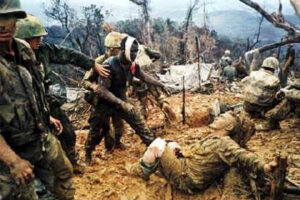
That evening the Rattlers were determined to get some resupply to the grunts and haul out some of the wounded. The slick (Huey all-purpose lift helicopter) aircraft commander was 1LT Ted Shulsen, call sign Rattler 26. Shulsen’s peter pilot was an FNG (fine new guy) named Hart. Hart was a newly arrived WO-1 (Warrant Officer) on his first mission in Vietnam. The other crewmembers were Stephen Martino and Stewart Lavigne as crew chief and door gunner respectively.
The mission briefing was held at Baldy with the 196th TOC (tactical operations center) guys, Shulsen, and me. We all knew this mission was going to be hotter than hot, that the grunts needed the resupply, and that we really had to get this mission completed. Ted was to fly treetop level south to north from the river into the LZ. My Firebird fire team would fly east to west on a perpendicular axis to the LZ to draw fire away from Shulsen’s approach and landing.
Both Ted and I were in contact via the Rattler company radio frequency, and I remember Ted’s radio call from over the river as he commenced his low-level run to the LZ. As I positioned my fire team for the east/west run with a right break I could see Shulsen’s slick inbound from the river toward the LZ.
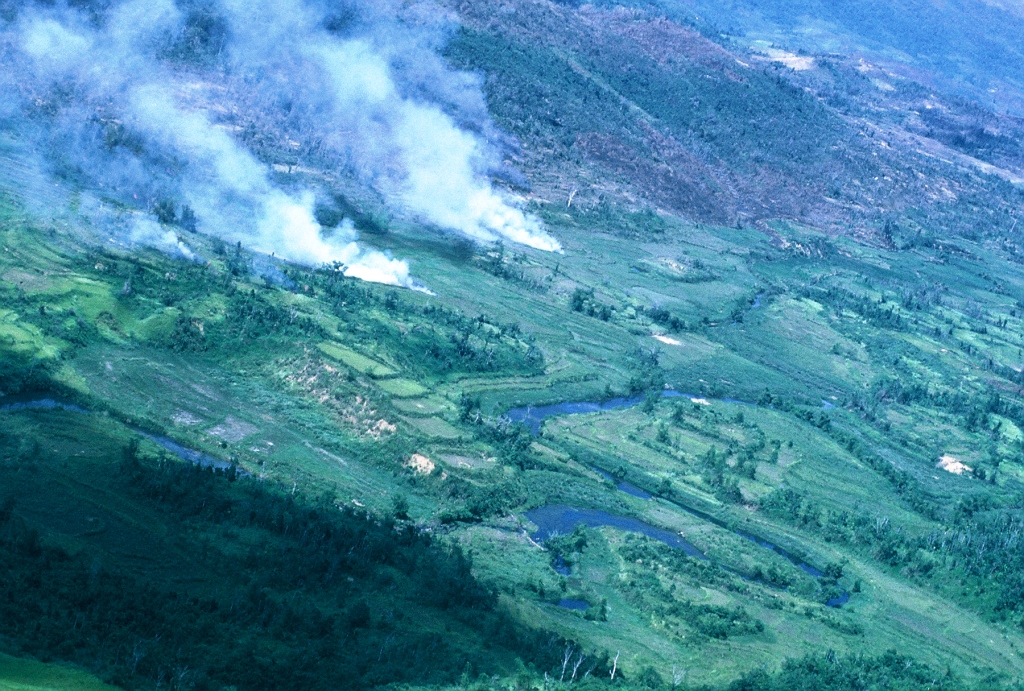
The exact sequence of events is a bit jumbled to me at this point. I recall that Shulsen’s approach to the LZ did not draw any ground fire. But once Shulsen landed in the LZ the world exploded. The bad guys were in the trees at his twelve o’clock position (nose) position and they opened up on him as the aircraft settled for landing. Shulsen screamed over the radio, ‘I’m hit, I’m hit!’ I could hear the sound of the ground fire in the radio transmission background.
At the same time as I am making my gun-run to the LZ (to draw fire away from Shulsen) the whole world erupts around both my gunship fire team.
There was an unbelievable amount of ground fire, noise, radio chatter, etc. To this day, I can still see a wisp of trailing black smoke pass underneath my chin bubble and between the helicopter skids. One of the bad guys had fired an RPG (rocket propelled grenade) directly at me on the nose of the helicopter gunship. He missed me only due to the ballistic ‘drop’ of the grenade projectile – that guy had me dead on, and dead. But we were lucky that day – he had missed.
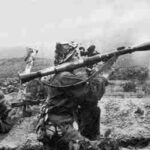
Ted Shulsen recalled the event as a mass of ground fire as he touched down. The next thing he remembered was looking over at his peter pilot who was slumped against his shoulder harness. Shulsen had a head wound that was spurting blood with every heartbeat onto the Plexiglas windscreen.
The grunts had placed three critically wounded soldiers in the ship before they noticed both Shulsen and Hart were shot. Seeing the carnage in the cockpit, they removed the wounded thinking there must be a better way to evacuate the wounded soldiers other than on this aircraft. Shulsen said he was aware of both Lavigne’s and Martino’s M-60 machine guns firing behind him.
Everything seemed to be occurring in slow motion to him. As he looked off to his left (slick aircraft commanders flew in the left seat) he recalled seeing an NVA soldier holding an AK 47 automatic rifle and taking aim at his aircraft. As he looked at the enemy soldier, a burst of M-60 fire from Martino hit the guy and instantly knocked him into next Tuesday.
When I heard Ted screaming that he was hit and remembering that Shulsen’s peter pilot (Hart) was an FNG, I yelled over the radio to get the ship out of the LZ. I had no way of knowing that Hart had also been wounded. The aircraft just sat running in the Landing Zone. No radio communication came from either Shulsen or Hart. I figured these guys were either dead or badly wounded because the ship just sat there running. All this has taken place within the time of my first run and I fired every rocket onboard in one pass because of all the ground fire.
With Shulsen’s aircraft still running in the LZ (a grunt RTO was talking with the gunships on FM radio), I decided to drop the rocket pods, land in the LZ, and have Bob Combs jump into the slick and (maybe) fly it out. Bob was a slick senior aircraft commander (SAC) who was transitioning into the Firebird gunships. I briefed my crew and wingman on the plan.
My wingman would provide cover for us on the way in and my own crew would cover us once on the ground and help Combs with whatever was found in Shulsen’s ship. Just as we lined up for the descent and landing approach, Shulsen’s aircraft began wallowing off the ground, gaining altitude, and barely clearing the trees the bad guys are firing from. Shulsen called over the radio and said he and his peter pilot were both shot but he was able to fly the aircraft.
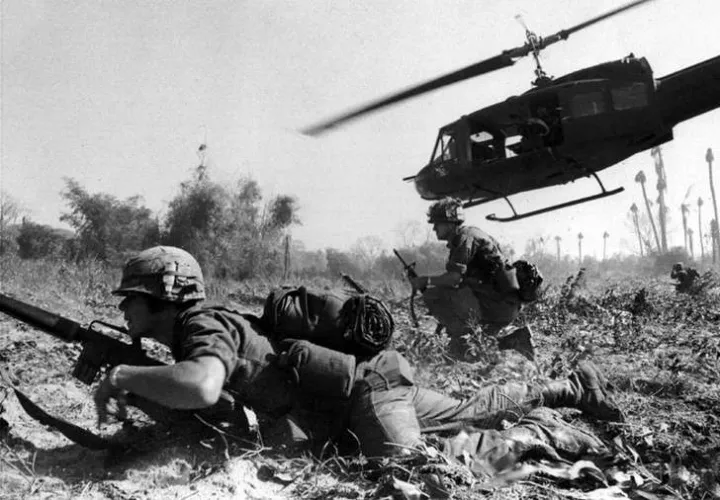
When Ted began his takeoff, he noticed the aircraft hydraulics were not functioning (similar to driving a car without the aid of power steering) but he knew he had to get away from the kill zone he was in. As he fought the aircraft into the air and clipped the trees in front of him, he noticed the aircraft hydraulics control switch had been knocked into the ‘off’ position. He immediately reset the switch to the ‘on’ position and regained flying control.
As Shulsen flew the aircraft while holding his hand over the blood spurting wound, he heard a voice say, ‘Do you need any help?’ It was his copilot Hart who had been hit three or four times in his ‘chicken plate’ (bulletproof body armor) and had been knocked unconscious by the blows from the bullets striking his ‘chicken plate.’ Hart had also been hit in the leg but he was alive. Startled by Hart’s question, Ted almost jumped through the ‘greenhouse (green tinted Plexiglas window above the pilot’s head). Fortunately for Ted he was strapped into his seat.
Shulsen flew the aircraft to the closest friendly area at LZ Center where he half landed/crashed onto the eastern ridge of the LZ. By this time daylight was running out and darkness beginning to settle over the LZ. Shulsen and Hart were carried from the still running aircraft with no one on the ground able to shut the damn thing down.
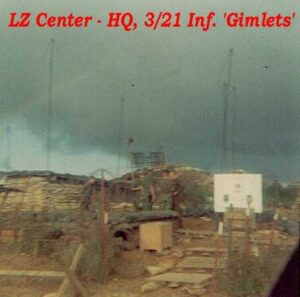
I landed/slid my gunship onto the east ridges alongside the still running slick, Bob jumped out of the gunship, into the waiting slick, and took off into the impending darkness for LZ Baldy with my gun team flying his escort.
The slick had been so badly shot up that the electrical system was gone, the instrument panel was nothing more than a mass of shattered glass, and the hydraulics were beginning to fail. No instruments, no lights, no nothing as we pressed on into the darkness toward Baldy.
Bob landed the shot-up slick on the airfield at LZ Baldy. After the aircraft was finally shutdown the extent of the damage was telling. One main rotor blade had sustained a .51 caliber hit (12.7 mm – it was BIG anyway!) that entered on the bottom of the blade leading edge, penetrated completely through the chordwise blade span, and exited the top of the trailing edge.
The main rotor blade had been cut almost in half. Other holes throughout the aircraft too numerous to count rendered it completely non-flyable. The slick was ‘hooked’ out the next day by a CH-47 ‘Chinook’ helicopter. A humorous side story here is that Bob had landed the wounded slick very near the Firebirds brand new ‘two holer’ latrine (it really was a nice, new outhouse!). When the ‘Hook’ hovered over the wounded slick for hook up/pick up, the tremendous down blast of the tandem rotors literally exploded the ‘two holer’ into a swirling storm of plywood, 2 x 4s, screen mesh, and corrugated metal pieces. What a shame!
Shulsen and Hart were both medevacd from LZ Center to medical treatment facilities at DaNang. When Ted regained consciousness in the DaNang hospital the treating doctor advised him that neither his head wound, nor his shoulder wound would affect his future flying plans. Both wounds would heal just fine. He asked, ‘What shoulder wound?’ as he looked over and discovered the bandages covering his second wound. Until that moment Ted had not realized he had been hit twice.
The following day both Shulsen and Hart were transferred from the DaNang hospital to a hospital at Cam Ranh Bay. That night the Cam Ranh Bay hospital was mortared, and Hart was again wounded. This time he sustained mortar fragments through one ear lobe.
From Cam Ranh Bay they both went to hospital in Japan where Hart was transferred back to the States. Ted was given the option of staying in Japan for recovery and returning to Vietnam or transferring to the States for recovery. Ted elected to convalesce in Japan and returned to the 71st within a few weeks’ time to complete his ‘short tour.’
The truly tragic ending to this story is that after surviving the horrific ground attack on their helicopter, Stephen Martino and James Lavigne were killed the next day as they crewed a Rattler slick commanded by WO1 Gerry Silverstein. The aircraft, flying command & control, was caught in a crossfire, exploded and rolled in flight, and crashed in a fiery ball instantly killing the four-man crew and six staff personnel of the 3/21st Infantry Regiment Battalion staff.
Many bad days for us in Death Valley but at least I would return home in less than 60 days.
(c) Copyright – 2023 Vic Bandini